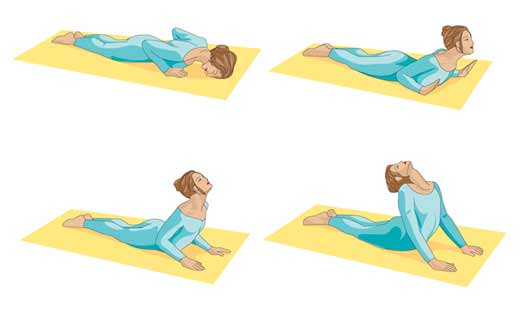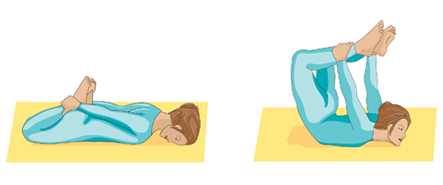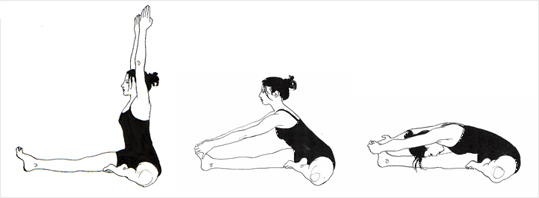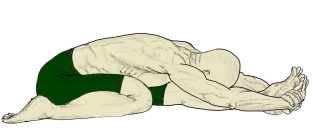1. THE COBRA
Do this in easy stages. Lie down, face prone, legs tightly together and stretched back, forehead on the floor. Put your hands, palm down, just under your shoulders. Inhale and raise your head, pressing your neck back, now use your hands to push your trunk up until you are bending in a beautiful arc from your lower spine to the back of your neck. You need go no further than this. However, if you are supple enough, you can now straighten your arms completely, bend the legs at the knees and drop your head back to touch your feet. Even if your head goes nowhere near your feet, drop it back as far as possible and hold the posture with deep breathing. Come out of the posture very slowly, returning to the face prone posture. Relax with your head to one side. Repeat.
2. THE BOW
This is also an extreme version of the simple bow. It is surprising how many children can do it immediately. Take it, once again, in easy stages. Lie face prone on your mat. If you are very slim have a nice thick, padded mat for this one. Inhale and bend your knees up. Stretch back with your arms and catch hold of your ankles, keeping fingers and thumbs all together on the outside. Inhale and at the same time raise your head and chest, pulling at your ankles and lifting knees and thighs off the floor. Breathe normally, trying to kick up your legs higher and lifting your head up. You are now bent like a bow, balancing the weight of your body on your abdomen. You can stop right here but if you can still stretch further, then slide your hands down your legs, lift them higher, keep the knees together and pull back as much as you can. Hold for a few normal deep breaths, then relax back to the face-prone position, head to one side.
3. THE SHOOTING BOW
In Sanskrit this is known as Akarna Dhanurasana and one leg is drawn up like a shooting bow. Sit with both legs stretched out in front and back straight. Reach forward with both hands and clasp your feet, catching the right foot with the left hand and the left foot with the right hand. Inhale, bend the left knee and pull the foot across the body, close to your chest, pointing the elbow up and twisting the body slightly to the right. The left hand stays firm and tight, holding the right foot. Hold posture with normal breathing, release slowly, and relax. Repeat on other side. In the beginning it is enough to hold the bent left leg with the right hand. When this is easy, stretch down and hold the left foot with the right hand. Continue to pull on the left foot, lifting it higher on each exhalation.











